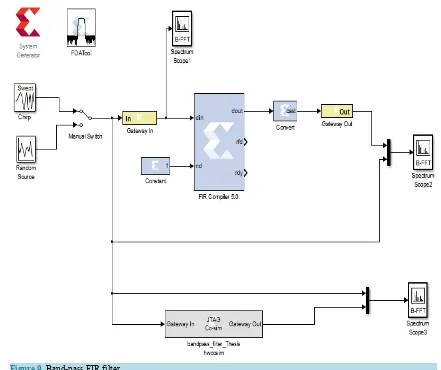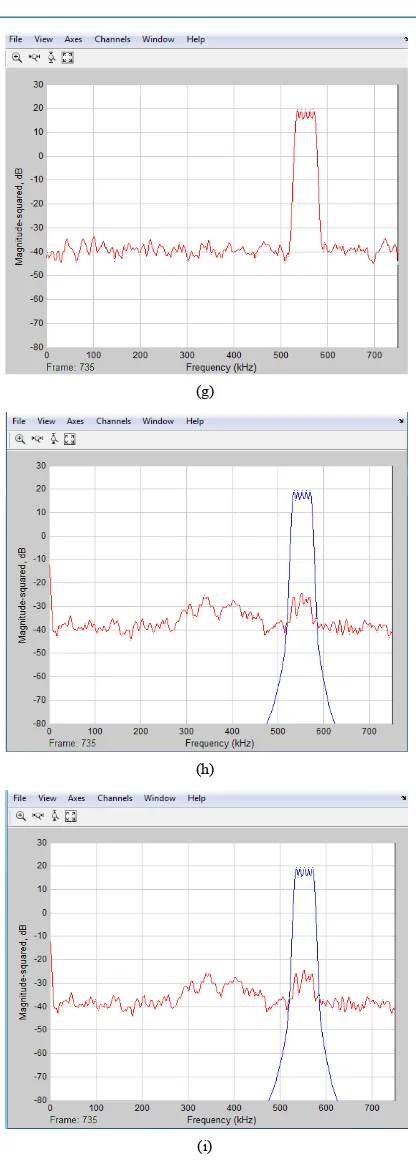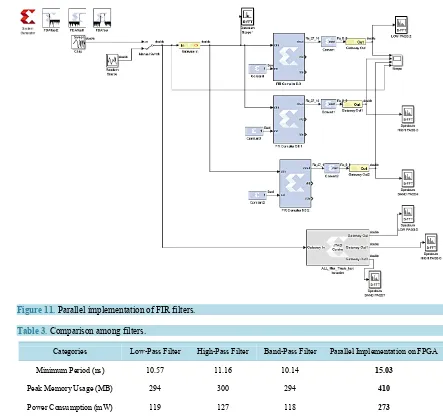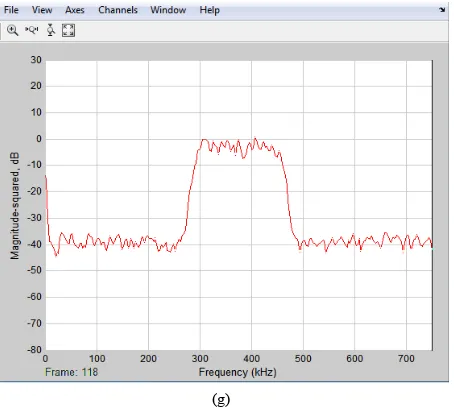http://dx.doi.org/10.4236/cs.2015.62004
Design and Implementation of Low-Pass,
High-Pass and Band-Pass Finite Impulse
Response (FIR) Filters Using FPGA
Emmanuel S. Kolawole, Warsame H. Ali, Penrose Cofie, John Fuller, C. Tolliver, Pamela Obiomon
Department of Electrical and Computer Engineering, Prairie View A&M University, Prairie View, USA Email: ekolawole@student.pvamu.edu, whali@pvamu.edu, pscofie@pvamu.edu, jhfuller@pvamu.edu, pobiomon@pvamu.edu
Received 1 February 2015; accepted 15 February 2015; published 15 February 2015
Copyright © 2015 by authors and Scientific Research Publishing Inc.
This work is licensed under the Creative Commons Attribution International License (CC BY). http://creativecommons.org/licenses/by/4.0/
Abstract
This paper presents the design and implementation of a low-pass, high-pass and a hand-pass Fi-nite Impulse Response (FIR) Filter using SPARTAN-6 Field Programmable Gate Array (FPGA) de-vice. The filter performance is tested using Filter Design and Analysis (FDA) and FIR tools from Mathworks. The FDA Tool is used to define the filter order and coefficients, and the FIR tool is used for Simulink simulation. The FPGA implementation is carried out using Spartan-6 LX75T-3FGG676C for different filter specifications and simulated with the help of Xilinx ISE (Integrated Software Environment). System Generator ISE design suit 14.6i is used in synthesizing and co-simulation for FPGA filter output verification. Finally, comparison is done between the results obtained from the software simulations and those from FPGA using hardware co-simulation. The simulation wave-forms and synthesis reports verify the parallel implementation of FPGA which proves its effec-tiveness in terms of speed, resource usage and power consumption.
Keywords
Digital Filters, FIR Filter, Matlab Simulink, FDA Tool, FIR Tool, Distributed Arithmetic, FPGA, Xilinx System Generator
1. Introduction
filter block diagram is as shown in Figure 1 [10].
An ideal filter is a network that allows signals of only certain frequencies to pass while blocking all others. Depending on the region of frequencies that are allowed through or not, filters are characterized as low-pass, high-pass, band-pass, band-reject and all-pass. There are many needs for electric filters, some of the more com-mon being those used in radio and television sets, which allow tuning into a certain channel by passing its band of frequencies while filtering out those of other channels [2].
The FIR filters are widely used in signal processing and can be implemented using programmable digital processors. Due to the high performance requirements and increasing complexity of DSP and multimedia com-munication applications, filters with a large number of taps are required to increase the performance in terms of high sampling rate. As a result, the filtering operations are computationally intensive and more complex in terms of hardware requirements [3]. The FIR filters perform the weighted summations of input sequences with con-stant coefficients in most of the signal processing and multimedia applications. The FIR filter is a digital filter widely used in Digital Signal processing applications in various fields like imaging, instrumentation and com-munications. Programmable digital processor signal (PDPS) can be used in implementing the FIR filter. Nowa-days, to make a difference on the market, new industrial control systems have to be highly performing, very flexible and reliable. At the same time, the cost is a key issue.
In order to reduce the cost, time-to-market has to be shortened, the price of a controller device has to be cheap and its energy consumption needs to be reduced [4]. This cost reduction is all the more challenging that new in-dustrial control systems are based on ever increasing sophisticated control algorithms which need a lot of puting resources and need reduced execution time. However, in realizing a large order filter many complex com-putations are needed which invariably affect the general performance of the common digital signal processors in terms of speed, cost flexibility, stability and so on.
To cope with all these challenges, designers rely more on mature digital electronics technologies that come with friendly software development tools. Following this development, a Field-Programmable Gate Array (FPGA) has become an extremely cost-effective means of realizing computationally intensive digital signal processing algorithms to improve overall system performance.
The FIR filter implementation in FPGA utilizing the dedicated hardware resources can effectively achieve ap-plication-specific integrated circuit (ASIC)-like performance while reducing development time cost and risks [4] [5]. Hence, FPGA has become the best choice for the design of signal processing system due to its greater flex-ibility and higher bandwidth.
In this paper FDA tool from Matlab mathematical computational package with digital signal processing tool-boxes is used to design filter response and generate coefficients tables. In the proposed approach, FIR tool uti-lizes distributed arithmetic (DA) as shown in Figure 2which actually uses lookup table for storing constant coefficients. So, the use of lookup tables reduces the hardware complexity and hence the new design is more ef-ficient in terms of less area, more speed and low power consumption due to its parallel implementation on FPGA, unlike the traditional DSP that utilizes MAC (unit multiplier and add accumulator) which increases memory re-sources as filter order increases [6]. System Generator package provided by Xilinx is used for FPGA implemen-tation of each filter specification. The overall filter output waveforms and synthesis reports performances under parallel implementation of FPGA are greatly enhanced with the proposed method.
2. FIR Filters Design
The design of an FIR filter for a specific application includes calculating the coefficients according to different criteria like filter order, sampling frequency, pass-band and stop-band frequencies, etc. The coefficient calculating could be done by different software which makes it as simple task. There are different methods used in designing Digital FIR Filters, such as Equiripple, window, least-square, frequency sampling and interpolated FIR method. In this paper, I have chosen Equiripple method because:
• It meets specifications with the least number of coefficients; • Uses less amount of resources on FPGA for implementation;
• The weighted approximation error between the desired and actual frequency response is spread evenly across the pass-band and stop-band of the filter thereby minimizing error;
Figure 1. A block diagram of a FIR filter [10].
Figure 2. Implementation of FIR filter using DA [6].
(1)
where:
is the best approximation frequency response; is the ideal frequency response;
is the weighting function; is the Equiripple factor.
Table 1as shown below elaborates the specifications of low-pass, high-pass and band-pass filters used in this paper:
Table 1. FIR filters specifications.
Options Low-Pass Filter High-Pass Filter Band-Pass Filter Design Method FIR Equiripple FIR Equiripple FIR Equiripple
Frequency Specifications Units: KHz Units: kHz Fs: 1500 F-stop: 300 F-pass: 270 Units: kHz Fs: 1500 F-stop: 450 F-pass: 480 Units: kHz Fs: 1500 F-stop1: 270 F-stop2: 480 F-pass1: 300 F-pass2: 450 Magnitude Specification Units: dB A-stop: 54 dB
A-pass: 1 dB
Units: dB A-stop: 54 dB
A-pass: 1 dB
Units: dB A-stop1: 54 dB A-stop2: 54 dB A-pass: 1 dB
FIRs have the advantage of being much more realizable in hardware [7] because they avoid division and feedback paths. FIR filter response y n
( )
is computed by operation between filter coefficients b k( )
and the data input x n( )
as shown by the equation:[ ]
1[
]
0 N
k k
y n −h x n k
=
=
∑
⋅ − (2)where
[
]
x n k− = the filter input; k
h = the filter coefficients;
[ ]
y n = the filter output;
N= the number of filter coefficients (order of filter).
The value of the constant k is a minimum value for which the expression N≤2k is valid.
(2)
1 log N
k= + . where the operator represents rounding down to a less value.
In FIR filter design, filter frequency response coefficients and the corresponding window type function must be known before filter hardware realization. Table 2 shows the transfer function equations used in different types of filters [8].
The value of variable n ranges between 0 and N, where N is the filter order. A constant M can be expressed as 2
M =N . Also M =2N. Since the variable n ranges from 0 and N, the ideal filter frequency response has N + 1 sample. h nd
[ ]
is the frequency response of each individual filter classification to be designed: low-pass, high- pass or band-pass filter.The FIR filter coefficients are found using the following expression:
[ ]
[ ] [ ]
d ; 0 1h n =w n h n⋅ ≤ ≤n N− (3) For direct realization of FIR filter, it is based on the direct implementation of this expression:
[ ]
N 1[ ] [
]
k o
y n −h k x n k
=
=
∑
⋅ − (4)[ ]
w n is the window function coefficients. In this design, Hamming window function is used based on the filter specification. For Hamming window, the expression for w n
[ ]
is given as;[ ]
0.54 0.46 1 cos 2π , 0 1 1n
w n n N
N
= − − ≤ ≤ −
−
(5)
Table 2. The frequency responses of standard ideal filters [8].
Type of Filter Frequency Response h nd
[ ]
Low-Pass Filter [ ]
( ) ( ) sin ; π c d n M
h n n M
n M ω − = ≠ − , πc n M
ω =
High-Pass Filter [ ]
( )
(
)
( ) sin ; π c d n Mh n n M
n M ω −
= − =
−
1 ; πc n M
ω
− ≠
Band-Pass Filter
[ ] sin
(
(2( ) ))
sin(
(1( ) ))
;π π
c c
d
n M n M
h n n M
n M n M
ω − ω −
= − ≠
− −
2 1;
π
c c n M
[image:5.595.139.494.124.702.2]ω −ω =
Figure 3. The direct architecture of a typical FIR filter [7].
[image:5.595.140.488.405.707.2]based on specification. Following the same procedure, high-pass and band-pass filters are equally generated based on their specifications.
3. FPGA Implementation of FIR Filter
After designing the filters based on their specifications from Matlab, the Xilinx software package provided by Spartan-6 FPGA board, System Generator is then used for the appropriate FIR FPGA filter implementation for low-pass, high-pass, band-pass filter as shown in Figures 5-9.
3.1. Simulation Results for Low-Pass FIR Filter
Figure 6(b) and Figure 6(c) verified the comparison between the low-pass filter simulation from Matlab and FPGA implementation. Figure 6(a) is the Input signal below
( )
FC using chirp source. Where( )
FC is the cut-off frequency.Figures 6(d)-(f) analyzed when the input signal is above the cut-off frequency and no output waveforms for low-pass frequency.
Figure 7displays the FPGA implementation on high-pass filter while the corresponding Figure 8(b) and Figure 8(c)verify the comparison between the high-pass filter simulation from Matlab and FPGA implemen-tation.Figure 8(a) is the input signal using chirp source when the signal is above the cut-off frequency.
3.2. Simulation Results for High-Pass FIR Filter
Figures 8(d)-(f)represent the output waveforms from Matlab and FPGA for High-pass when the input signal is below
( )
FC . High-pass did not pass at low frequency.Figure 9displays the FPGA implementation on band-pass filter while the corresponding Figure 10(b) and Figure 10(c)verify the comparison between the band-pass filter simulation from Matlab and FPGA implementa-tion.Figure 10(a) is the input signal using chirp source when the signals are between
( )
FC1 and( )
FC2 . Band-pass passes frequency when the frequency is within the specified bandwidth.
(a)
(b)
(d)
(e)
(f)
[image:8.595.209.420.81.673.2]Figure 7. High-pass FIR filter.
3.3. Simulation Results for Band-Pass FIR Filter
Figures 10(d)-(f) represent the output waveforms from Matlab and FPGA for band-pass when the input signal is below
( )
FC1 .Band-pass did not pass at frequency lower that( )
FC2 .Figures 10(g)-(i) represent the output waveforms from Matlab and FPGA for band-pass when the input signal is below
( )
FC1 .Band-pass did not pass at frequency above that( )
FC2 .4. Parallel Implementation on FPGA
Figure 11 identifies the true parallelism nature of FPGA, so different processing operations do not have to compete for the same resources. Each independent processing task is assigned to a dedicated section of the chip, and can function autonomously without any influence from other logic blocks [9]. As a result, the performance of one part of the application is not affected when more processing blocks are added [3].
5. Simulation Results for Parallel Implementation
When the three filters were combined in parallel with individual specifications, the same output waveforms for all the filters were observed which actually proved the parallelism nature of FPGA. With input signal using ran-dom source as shown in Figures 12(a)-(g)verified the comparison between the low-pass, high-pass and band- pass filters simulations from Matlab and FPGA parallel implementation.
6. Discussions
(a)
(b)
(d)
(e)
(f)
[image:11.595.206.423.80.674.2]Figure 9. Band-pass FIR filter.
From Table 3, cited from the synthesis report of the implementation, it is shown that the minimum imple-mentation time for low-pass filter is 10.57 ns with peak memory usage of 294 MB and power consumption of 119 mW; for high-pass filter, the corresponding time is 11.16ns with peak memory usage of 300 MB and power consumption of 127 mW; for band-pass filter the corresponding time is 10.14 ns with peak usage memory of 294 MB and power consumption of 118mW. Therefore, the total period, total memory usage and power con-sumption for all the three filters when implemented separately are 31.87 ns, 888 MB and 364 mW as against 15.03 ns, 410 MB and 273 mW when parallel implemented on FPGA. This analysis and parameters are used to evaluate the advantages of FPGA and equally validate the effectiveness of parallel implementation of FPGA as earlier discussed.
In addition, below are some of the factors used in evaluating the advantages of FPGA:
1) Time to market―FPGA technology offers flexibility and rapid prototyping capabilities in the face of in-creased time-to-market concerns. You can test an idea or concept and verify it in hardware without going through the long fabrication process of custom ASIC design. It is easy to implement incremental changes and iterate on an FPGA design within hours instead of weeks;
2) Cost―The nonrecurring engineering (NRE) expense of custom ASIC design far exceeds that of FPGA-based hardware solutions. With FPGA, it means that you have no fabrication costs or long lead times for assembly. This is because system requirements often change over time, the cost of making incremental changes to FPGA designs is negligible when compared to the large expense of re-designing an ASIC;
(a)
(b)
(d)
(e)
(g)
(h)
(i)
Figure 10. (a) Input signal between
( )
FC1 and( )
FC2 using chirp source; (b) Output waveform from band-pass FIR filter using Matlab; (c) Output waveform from band-pass FIR filter using FPGA; (d) Input signal be-low
( )
FC1 using chirp source; (e) Output waveform from band-pass FIR filter using Matlab; (f) Outputwave-form from band-pass filter using FPGA; (g) Input signal above
( )
FC2 using chirp source; (h) Output [image:15.595.210.418.69.650.2]Figure 11. Parallel implementation of FIR filters.
Table 3. Comparison among filters.
Categories Low-Pass Filter High-Pass Filter Band-Pass Filter Parallel Implementation on FPGA
Minimum Period (ns) 10.57 11.16 10.14 15.03
Peak Memory Usage (MB) 294 300 294 410
Power Consumption (mW) 119 127 118 273
challenges. Due to reconfigurable nature of FPGA chips, it can keep up with future modifications that might be necessary. As a product or system matures, you can make functional enhancements without spending time rede-signing hardware or modifying the board layout;
4) Performance―The hardware parallelism nature of FPGAs exceed the computing power of digital signal processors (DSPs) by breaking the paradigm of sequential execution and accomplishing more per clock cycle.
Controlling inputs and outputs (I/O) at the hardware level provides faster response times and specialized func-tionality to closely match application requirements. This again evaluates and validates the parallelism nature of FPGA;
5) Reliability―Due to the fact that software tools provide the programming environment, FPGA circuitry is truly a “hard” implementation of program execution. Processor-based systems often involve several layers of concept to help schedule tasks and share resources among multiple processes. For any given processor core, on-ly one instruction can execute at a time, and processor-based systems are continualon-ly at risk of time-critical tasks preempting one another. Because FPGAs do not use OSs, it minimizes reliability concerns with true parallel ex-ecution and deterministic hardware dedicated to every task.
7. Conclusion
(a)
(b)
(d)
(e)
(g)
Figure 12. (a) Input signal using Random source for parallel implementation; (b) Output waveform from low-pass FIR filter using Matlab; (c) Output waveform from low-pass filter using FPGA parallel implementation; (d) Output waveform from high-pass FIR fil-ter using Matlab; (e) Output waveform from high-pass filfil-ter using FPGA parallel im-plementation; (f) Output waveform from band-pass FIR filter using Matlab; (g) Output waveform from band-pass filter using FPGA parallel implementation.
The simulation results show that the output waveforms obtained from the software simulations correspond with those from FPGA implementation respectively using hardware co-simulations. Also, the parallel implementation proves that performance of a low-pass filter is not affected by both high-pass and band-pass filter and vice-versa, and the synthesis report equally shows less resource usage, speed increase, cost effectiveness, more flexibility and low power consumption which validate the parallelism nature of FPGA.
References
[1] Ruan, A.W., Liao, Y.B. and Li, J.X. (2009) An ALU-Based Universal Architecture for FIR Filters. IEEE Proceedings of International Conference on communications, Circuits and Systems, Milpitas, July 2009, 1070-1073.
[2] Panayotatos, P. (2005) Frequency Response of Filters. Rutgers University, New Brunswick.
[3] Quayyum, A. and Mazher, M. (2012) Design of Programmable, Efficient Finite Impulse Response Filter Based on Dis-tributive Arithmetic Algorithm. International Journal of Information Technology and Electrical Engineering, 1, 19-24. [4] Monmasson, E., et al. (2011) FPGAs in Industrial Control Applications. IEEE Transactions on Industrial informatics,
7, 224-243. http://dx.doi.org/10.1109/TII.2011.2123908
[5] Wenjing, H., Guoyun, Z. and Waiyun, L. (2011) Self-Programmable Multipurpose Digital Filter Design Based on FPGA. IEEE Proceedings of International Conference on Internet Technology and Applications (iTAP), Wuhan, Au-gust 2011, 1-5.
[6] Mohanakrishnan, S. and joseph, B.E. (1995) Automatic Implementation of FIR Filters on Field Programmable Gate Arrays. IEEE Signal Processing Letters, 2, 51-53.
[7] Manal, H.J. and Asaad, H.S. (2013) High-Pass Digital Filter Implementation Using FPGA. IEEE International Journal of Advanced Computer Science and Applications (IJACSA), 13, 41-50.
[8] Abdullah, H.N. (2008) Design and Implementation of Programmable FIR Filter Using FPGA. Engineering and Tech-nology Journal, 26.
[9] Xilinx White Paper Number 6984. www.xilinx.com
[image:19.595.202.429.84.289.2]![Figure 1. A block diagram of a FIR filter [10].](https://thumb-us.123doks.com/thumbv2/123dok_us/8174061.808715/3.595.104.530.81.543/figure-block-diagram-fir-filter.webp)
![Figure 3. The direct architecture of a typical FIR filter [7].](https://thumb-us.123doks.com/thumbv2/123dok_us/8174061.808715/5.595.140.488.405.707/figure-direct-architecture-typical-fir-filter.webp)






